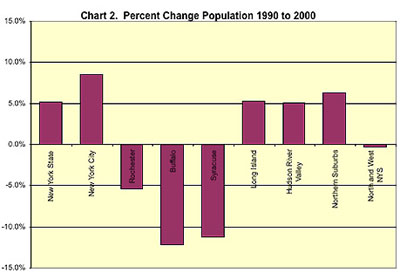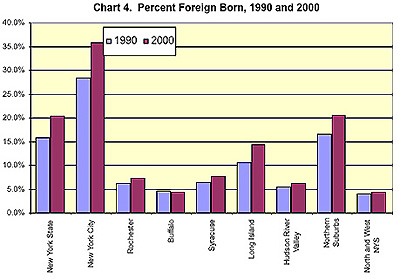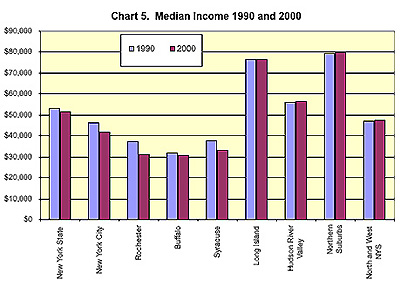The court fight over funding for public education in New York -- in which a judge agreed that New York City’s schoolchildren were being shortchanged in favor of schools throughout the rest of the state -- is just the latest and most visible example of the old and bitter relationship between upstate and downstate (which means both New York City and its suburbs). New conflicts arise; old ones never seem to die.
A look at the regions’ differing demographics helps explain why this relationship continues to be so difficult.
Downstate Grows, Upstate Does Not
New York City's population accounts for almost half of the state. Throw in Long Island and the northern suburbs (Westchester, Rockland and Putnam) and downstate accounts for almost two-thirds of the state. New York City is the states only "first class city." It is joined by four 2nd class cities, Yonkers (just north of the Bronx), Syracuse, Rochester and Buffalo. The few hundred thousand population of each of these cities is dwarfed by the size of New York City and its suburbs.

While New York City and its suburbs have been growing, the three upstate cities are hemorrhaging population, as is the entire region north and west of the Albany that contains them.

Largely this is due to the loss of the industrial base in Western New York State along with some redistribution of population from the old cities to the surrounding suburbs. These trends also affect the city and its suburbs, but newer economic opportunities in finance, higher technology and corporate headquarters offset the loss of industrial firms. These trends are unlikely to be quickly reversed. Western New York has been losing population for decades, and white and middle class flight to suburbs started even before World War II.
New York City is Diverse, the Suburbs and Upstate are Not
New York City is less and less like upstate New York and less and less like its suburbs. The racial and ethnic composition of the city is very different from the upstate cities, and even more different from the rest of downstate--the city's suburbs and the Hudson River Valley area.

While foreign born residents flocked to the city and suburbs, they have not changed the composition of upstate New York in any substantial way. So though New York City shares the foreign born population with its suburbs, the city's racial and ethnic diversity is much greater than either upstate or the suburbs.

New York is a foreign and minority city with high paying industries such as the financial sector. The rest of the state consists of rural and semi-rural areas mostly inhabited by native-born whites, mostly white suburban communities, and some declining industrial cities.
Not surprisingly, the rest of the state is either jealous of New York City's economic prowess, or suspicious or hostile to its largely minority and foreign residents, or both.
Money and Children Matter
The differences and trends between the city, the suburbs and upstate affect the money available for the city and elsewhere to provide needed services. They also affect where services are needed.

Plainly, resources are not as readily available for any of the cities to finance services such as education, as they are in the suburbs or the Hudson River Valley area. The state does make up some of the funding gaps for the upstate cities, but New York City with more than 42 percent of the city students still waits for the resources promised by the Campaign for Fiscal Equity case. Meanwhile, the suburbs appear, in general, to have adequate resources.
The trends in young and new students mean declines upstate, and increases downstate, most particularly in New York City. In short, there are more educational needs and they continue to grow, in exactly those areas where resources that can be tapped to fund them are lacking. Even in the suburbs, the areas of high need and population growth (e.g. Yonkers) have few available resources. New York City depends the rest of New York State for its funding for needed resources. Its chance of success in getting these resources, even with a popular Republican mayor, seems very slim.

Andrew A. Beveridge has taught sociology at Queens College since 1981, done demographic analyses for the New York Times since 1993, and provides expert testimony on a range of cases, including housing discrimination. The opinions expressed are his alone.




